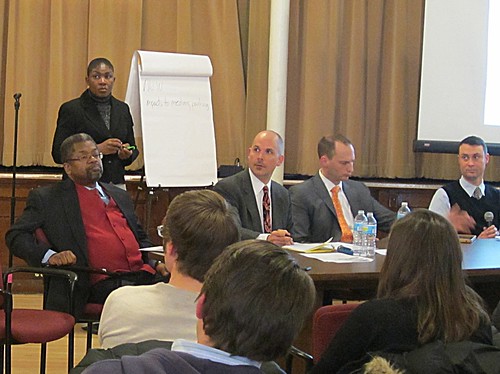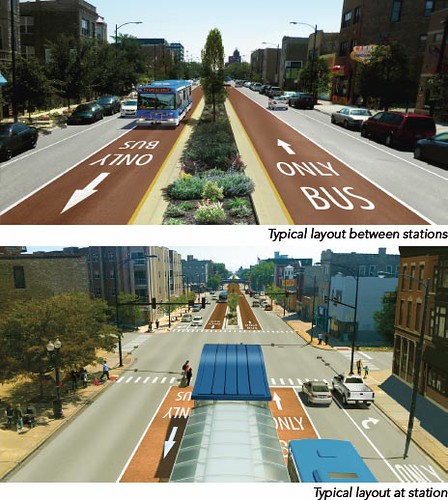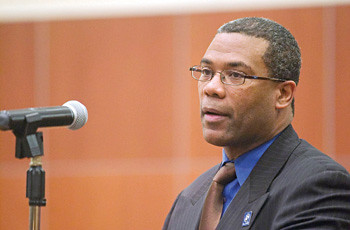The BRT NIMBYs are at it again. In January, the Ashland-Western Coalition, a consortium of chambers of commerce and community development groups on the Near West Side, hosted a public meeting where business owners panicked that the CTA’s plan to build bus rapid transit on Ashland would ruin them. Earlier this month the coalition announced an anemic alternative proposal to robust, center-running BRT service, which they euphemistically dubbed Modern Express Bus service, although this would only keep bus riders and drivers alike stuck in the same old traffic jams.
MEB would be simply bringing back the defunct curbside X9 Ashland express buses, plus traffic signal prioritization and bus stops located at the far side of intersections to facilitate right turns by cars, plus a few cosmetic changes. Despite making fewer stops, the X9 buses still crawled along at an average speed of 10.3 mph during rush hours, only marginally faster than the local buses, since they also had to navigate travel lanes clogged with private cars, and were delayed by parking cars, taxis picking up and dropping off passengers, and double-parked vehicles.
Unlike the CTA’s plan, detailed in the above video, which involves converting car lanes to dedicated bus lanes and the elimination of left turns, boosting average peak-hour bus speeds, including stops, to a projected 15.9 mph, MEB would not enable buses to bypass traffic congestion at all. It would provide only a minimal benefit for riders, and it would do almost nothing to make the street safer and more efficient. It's a bus plan that's designed not to improve transit service, but to avoid inconveniencing motorists.
The coalition’s anti-BRT machinations would be laughable, if they weren’t so dangerous. A community meeting the group held on Tuesday demonstrated that they’ve got the attention of local politicians, and the CTA’s plan for “gold-standard,” fast-moving BRT could easily be watered down if the NIMBYs persuade local leaders to oppose it. The coalition’s announcement for the meeting telegraphed the group’s anti-BRT agenda:
- Support Coalition’s effort to improve CTA buses
- Learn about CTA’s plan to spend over $160 million to transform Ashland by eliminating 50% of vehicles, all left turns and bicycles
- Hear Coalition’s plan to modernize Ashland bus services and maintain Ashland’s capacity for vehicles, buses and bicycles
Of course, the CTA plan isn’t going to be eliminating 50 percent of motor vehicles, just half of the car lanes, and it will be making room for more people to travel the corridor more efficiently, since each bus can replace dozens of cars, and because buses won’t be delayed by traffic jams. And, no, BRT won’t eliminate bicycles. Bike lanes won’t be added, but cycling will still be permitted on the street, which is currently an unpleasant place to bike anyway since it’s a four-lane arterial. If anything, BRT will make Ashland more bikeable, since it will discourage speeding by car drivers.
Steven Vance and I weren’t able to attend the meeting, held at the First Baptist Congregational Church, 1613 West Washington, but a couple of transit advocates who were there provided details. According to architect and planner Jacob Peters, a member of the First Ward Transportation Advisory Committee, about 30 people attended, hardly a show of strength on the part of the NIMBYs. However, 27th Ward Alderman Walter Burnett was there, as well as representatives of First Ward Alderman Joe Moreno, 25th Ward Alderman Danny Solis, and 7th District Congressman Danny Davis. Roger Romanelli, executive director of the Randolph/Fulton Market Association, led the meeting.
“They ran through an overview of why the current bus service is not working, and they were harsher on the current bus than the BRT,” Peters said. “They then summarized the BRT proposal in their own words, as well as their critique of the proposal. Lastly they summarized their [MEB] plan, using some misleading terms, like ‘World Class Bus Service.' Then they took questions from the audience and, to Roger’s credit, he tried to keep the tone civil towards us BRT supporters.”
“The business owners sat at the back of the room, and were all opposed to reducing capacity and turns,” Peters said. “They pounded home the concept that there are only three streets to move freight north-south in the city. The residents were primarily seated in the front, and were most loudly critical of a failure [by the city] to manage traffic for United Center events, which they saw as indicative of [the traffic problems] BRT would cause them on a nonstop basis.”
“They had a lot of political people there,” reported Lindsay Bayley, a planner with the Chicago Metropolitan Agency for Planning and an Ashland corridor resident, who was attending in a non-official capacity. “They said, ‘We already have one alderman who is on board with our proposal.’ So I asked, ‘Which one?’ and they uneasily looked around, and finally Burnett was like, ‘They're talking about me.’ And everyone cheered and he clarified that he wants the CTA to consider what they're proposing.”
“One of the people at the front of the room, part of the coalition, went on a little diatribe about driving,” Bayley added. “She said, ‘It doesn't matter what you do to the bus! I will never take a bus! I will drive until the state won't give me a license anymore.’ So it clearly shows that there are people in the coalition who don't care about bus service; they care about protecting their status quo. And their plan? Lipstick on a pig.”
Bayley said she talked to Burnett after the meeting. “He basically said, ‘This is my church. These folks have some important concerns, but not everything this group is saying is true and I don't agree with everything they say, but those left turn considerations - if the BRT proposal didn't have those left turn restrictions, most of these people wouldn't be here. And [the coalition] doesn't seem to include many people who ride the bus...we need more bus riders to come out and discuss this.’”
Peters also talked to Burnett and Romanelli after the meeting. “Our conversation ranged from how BRT without dedicated lanes is as toothless as a gummy bear, to developing zoning and financing programs to lessen the negative impacts of gentrification caused by transformative transportation projects. Many of the attendees were woefully uninformed about the BRT project, which Burnett chastised Romanelli for. I hope to have continued discussions with Roger, and get him to realize that an attempt at sabotaging the entire proposal will only make his group the villain in a narrative of everyday transit users versus those who seem entitled to personal priority usage of the road for their own selfish reasons.”
“Burnett is not as much of an enemy of BRT as the coalition would like to believe,” Peters added. “A meeting proposing alternative tweaks to the plan which retain some left hand turns, and a study which shows the futility of what the coalition is proposing would easily give him the political safety to be a proponent of BRT, especially if he hears a concerted voice from transit riders in his ward from all races and income levels. There needs to be a coalition of community groups which support BRT.”
The Active Transportation Alliance, which has been helping to mobilize support for the CTA's plan, opted not to send a representative to the anti-BRT meeting, but Brenna Conway, manager of its Riders for Better Transit Campaign, provided the following statement:
There is more community engagement around Bus Rapid Transit than this one meeting shows. To date 23 businesses and organizations have signed on as supporters of Bus Rapid Transit. Additionally over 1400 Chicago residents have sent letters of support for BRT to their local elected officials asking for gold-standard BRT on Ashland and across Chicago. Central to their support is that BRT provides the time savings for riders and economic benefits that come with implementing the major features such as bus-only lanes, stations with off-board fare collection, well-spaced stops and traffic signal prioritization. We and the residents, businesses and organizations that have signed on are supportive of BRT on Ashland because we need to rethink how we’re using limited street space to create safer streets that better serve all Chicagoans.
As Conway stated, there already is a broad base of support for the Ashland BRT proposal. But proponents need to make themselves at least as visible to local elected officials as the NIMBYs are. Chicagoans who want fast, reliable BRT service on Ashland, not a watered-down alternative that only maintains the dysfunctional status quo, need to speak up. Contact your alderman and sign Active Trans' petition to voice your support for the CTA's plan.








